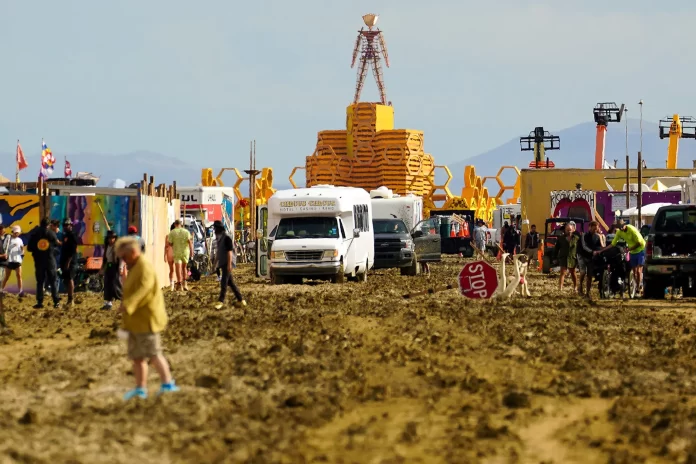
Annually, Burning Man becomes a remarkable spectacle as people from all over converge on Northern Nevada, arriving in extravagantly adorned vehicles and setting up intricate art installations in a remote desert area approximately two hours northeast of Reno.
However, this year’s edition made global headlines as nearly 70,000 participants found themselves stranded in the desert after a storm caused extremely muddy conditions, making travel on the Black Rock Playa – the historical lakebed hosting the event – nearly unfeasible. People had plastic bags strapped to their feet, were trudging through the thick mud, and numerous vehicles were abandoned somewhere between the festival’s Black Rock City and the closest paved road several miles away.
The New York Times called it
“a rain-gorged stew of mud and slop”
In a 2019 report addressing the festival’s public health and safety issues, the Bureau of Land Management, the federal agency responsible for overseeing the Black Rock-High Rock National Conservation Area, noted that a rainfall exceeding a quarter of an inch during a single rain event could make the playa impassable for motor vehicles. Such conditions would give rise to concerns related to sanitation and emergency response.
A comparable rainstorm occurred in 2014, causing travel suspension on the playa for approximately 12 hours. These rain events disrupted essential public services, including the maintenance of portable toilets and the accessibility of medical and law enforcement personnel.
Playa surface sediment is roughly 65 percent clay and 30 percent silt mixed with sand, according to Ken Adams, a Desert Research Institute professor emeritus who has studied the Black Rock Playa for decades. Soil with a high percentage of silt and clay has a higher water-holding capacity. Scientists, depending on their area of expertise, hold various apprehensions regarding the consequences of a rain-soaked Burning Man on the playa.
Adams, in particular, is focused on the potential effects on branchiopods. These minute crustaceans encompass species such as fairy shrimp, water fleas, and tadpole shrimp, which deposit their eggs in the arid playa soil, anticipating the arrival of the next flood.
Although the immediate crisis has passed, and festival attendees have now left the playa, the long-term environmental consequences of 70,000 people on this unique and delicate ecosystem are still uncertain.


